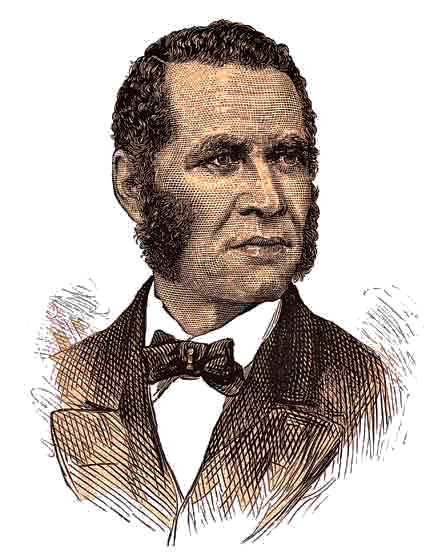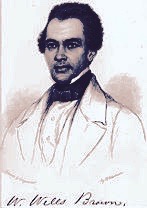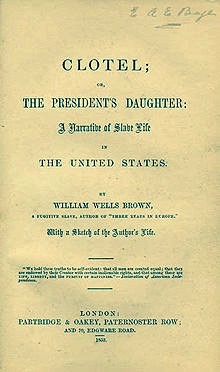William Wells Brown

A Black History Moment William Wells Brown
William Wells Brown
 William Wells Brown (circa 1814 – November 6, 1884) was a prominent African-American abolitionist lecturer, novelist, playwright, and historian in the United States. Born into slavery in Montgomery County, Kentucky, near the town of Mount Sterling, Brown escaped to Ohio in 1834 at the age of 20. He settled in Boston, where he worked for abolitionist causes and became a prolific writer. Amongst working for abolitionist causes, Brown also supported causes including: temperance, women’s suffrage, pacifism, prison reform, and anti-tobacconism. His novel Clotel (1853), considered the first novel written by an African American, was published in London, where he resided at the time; it was later published in the United States.
William Wells Brown (circa 1814 – November 6, 1884) was a prominent African-American abolitionist lecturer, novelist, playwright, and historian in the United States. Born into slavery in Montgomery County, Kentucky, near the town of Mount Sterling, Brown escaped to Ohio in 1834 at the age of 20. He settled in Boston, where he worked for abolitionist causes and became a prolific writer. Amongst working for abolitionist causes, Brown also supported causes including: temperance, women’s suffrage, pacifism, prison reform, and anti-tobacconism. His novel Clotel (1853), considered the first novel written by an African American, was published in London, where he resided at the time; it was later published in the United States.
Brown was a pioneer in several different literary genres, including travel writing, fiction, and drama. In 1858 he became the first published African-American playwright, and often read from this work on the lecture circuit. Following the Civil War, in 1867 he published what is considered the first history of African Americans in the Revolutionary War. He was among the first writers inducted to the Kentucky Writers Hall of Fame. A public school was named for him in Lexington, Kentucky.
Brown was lecturing in England when the 1850 Fugitive Slave Law was passed in the US; as its provisions increased the risk of capture and re-enslavement, he stayed overseas for several years. He traveled throughout Europe. After his freedom was purchased in 1854 by a British couple, he and his two daughters returned to the US, where he rejoined the abolitionist lecture circuit in the North. A contemporary of Frederick Douglass, Wells Brown was overshadowed by the charismatic orator and the two feuded publicly.
Life in Slavery
William was born into slavery in 1814 (or March 15, 1815) near Lexington, Kentucky, where his mother Elizabeth was a slave ( of Native American and Black ancestry). She was held by Dr. John Young and had seven children, each by different fathers. (In addition to William, her children were Solomon, Leander, Benjamin, Joseph, Milford, and Elizabeth.) William’s father was George W. Higgins, a white planter and cousin of his master Dr. Young. Higgins had formally acknowledged William as his son and made his cousin Young promise not to sell the boy. But Young did sell him with his mother. William was sold several times before he was twenty years old.
William spent the majority of his youth in St. Louis. His masters hired him out to work on steamboats on the Missouri River, then a major thoroughfare for steamships and the slave trade. his work allowed him to see many new places. In 1833, he and his mother escaped together across the Mississippi River, but they were captured in Illinois. In 1834, Brown made a second escape attempt, successfully slipping away from a steamboat when it docked in Cincinnati, Ohio, a free state. In freedom, he took the names of Wells Brown, a Quaker friend who helped him after his escape by providing food, clothes and some money. He learned to read and write, and eagerly sought more education, reading extensively to make up for what he had been deprived. Around this time he was hired by Elijah Lovejoy and worked with the famed abolitionist in his printing office.
Marriage and Family
In 1834, his first year of freedom, at age 20 Brown married Elizabeth Schooner, with whom he had two surviving daughters, Clarissa and Josephine. William and Elizabeth later became estranged. In 1851, Elizabeth died in the United States.
Brown had been in England since 1849 with their daughters, lecturing on the abolitionist circuit. After his freedom was purchased in 1854 by a British couple, Brown returned with his daughters to the US, settling in Boston. On April 12, 1860, the 44-year-old Brown married again, to 25-year-old Anna Elizabeth Gray in Boston.
In 1856, Well’s daughter Josephine Brown published Biography of an American Bondman (1856), an updated account of his life, drawing heavily on material from Wells Brown’s 1847 autobiography. She added details about abuses he suffered as a slave, as well as new material about his years in Europe.
Move to New York
From 1836 to about 1845, Brown made his home in Buffalo, New York, where he worked as a steamboat man on Lake Erie. He helped many fugitive slaves gain their freedom by hiding them on the boat to take them to Buffalo, or Detroit, Michigan or across the lake to Canada. He later wrote that during the seven-month period of time from May to December 1842, he had helped 69 fugitives reach Canada. Brown became active in the abolitionist movement in Buffalo by joining several anti-slavery societies and the Negro Convention Movement. Brown’s work in anti-slavery societies often included public speaking, frequently including the use of music. Brown’s use of music in his speeches emphasizes music’s role in the anti-slavery movement of the 1840s. While living in Buffalo, Brown also organized a Temperance Society which quickly gained 500 members. This statistic is especially impressive considering there were only 700 blacks at the time living in Buffalo.
Tens of thousands of slaves escaped to Canada. The First Report of the Anti-Slavery Society of Canada estimated that by 1852, 30,000 “Negro refugees” had reached Canada.
Years in Europe
In 1849, Brown left the United States with his two young daughters to travel in the British Isles to lecture against slavery. He wanted them to gain the education he had been denied. He was also selected as a representative of the US that year at the International Peace Congress in Paris. Given passage of the Fugitive Slave Act of 1850 in the US, he chose to stay in England until 1854, when his freedom was purchased by friends. As a highly visible public figure in the US, he was at risk for capture as a fugitive and re-enslavement. Slave catchers were paid high bounties to return slaves to their owners, and the new law required enforcement even by free states and their citizens, although many resisted.
Brown lectured widely to antislavery circuits in the UK to build support for the US movement. He often showed a metal slave collar as demonstration of the institution’s evils. An article in the Scotch Independent reported the following:
By dint of resolution, self-culture, and force of character, he Brown has rendered himself a popular lecturer to a British audience, and vigorous expositor of the evils and atrocities of that system whose chains he has shaken off so triumphantly and forever. We may safely pronounce William Wells Brown a remarkable man, and a full refutation of the doctrine of the inferiority of the negro.
Brown also used this time to learn more about the cultures, religions, and different concepts of European nations. He felt that he needed always to be learning, in order to catch up and live in a society where others had been given an education when young. In his 1852 memoir of travel in Europe, he wrote,
He who escapes from slavery at the age of twenty years, without any education, as did the writer of this letter, must read when others are asleep, if he would catch up with the rest of the world.
At the International Peace Conference in Paris, Brown faced opposition while representing the country that had enslaved him. Later he confronted American slaveholders on the grounds of the Crystal Palace.
Based on this journey, Brown wrote Three Years in Europe: or Places I Have Seen And People I Have Met. His travel account was popular with middle-class readers as he recounted sightseeing trips to the foundational monuments of European culture. In his Letter XIV, Brown wrote about his meeting with the Christian philosopher Thomas Dick in 1851.
Abolition Orator and Writer
After his return to the US, Brown gave lectures for the abolitionist movement in New York and Massachusetts. He soon focused on anti-slavery efforts. His speeches expressed his belief in the power of moral suasion and the importance of nonviolence. He often attacked the supposed American ideal of democracy and the use of religion to promote submissiveness among slaves. Brown constantly refuted the idea of black inferiority.
Due to his reputation as a powerful orator, Brown was invited to the National Convention of Colored Citizens, where he met other prominent abolitionists. When the Liberty Party formed, he chose to remain independent, believing that the abolitionist movement should avoid becoming entrenched in politics. He continued to support the Garrisonian approach to abolitionism. He shared his own experiences and insight into slavery in order to convince others to support the cause.
Literary Works
In 1847, he published his memoir, the Narrative of William W. Brown, a Fugitive Slave, Written by Himself, which became a bestseller across the United States, second only to Frederick Douglass’ slave narrative memoir. Brown critiques his master’s lack of Christian values and the customary brutal use of violence by owners in master-slave relations.
 Clotel, or, The President’s Daughter: A Narrative of Slave Life in the United States
Clotel, or, The President’s Daughter: A Narrative of Slave Life in the United States
When Brown lived in Britain, he wrote more works, including travel accounts and plays. His first novel, entitled Clotel, or, The President’s Daughter: a Narrative of Slave Life in the United States, was published in London in 1853. It portrays the fictional plight of two mulatto daughters born to Thomas Jefferson and one of his slaves. His novel is believed to be the first written by an African American.
Historically, Jefferson’s household was known to include numerous mixed-race slaves, and there were rumors since the early 19th century that he had children with a slave concubine, Sally Hemings. In 1826 Jefferson freed five mixed-race slaves in his will; historians now believe that two brothers, Madison and Eston Hemings, were among his four surviving children from his long-term relationship with Sally Hemings.
As Brown’s novel was first published in England and not until later in the United States, it is not the first African-American novel published in the US. This credit goes to either Harriet Wilson’s Our Nig (1859) or Julia C. Collins’ The Curse of Caste; or The Slave Bride (1865).
Most scholars agree that Brown is the first published African-American playwright. Brown wrote two plays after his return to the US: Experience; or, How to Give a Northern Man a Backbone (1856, unpublished and no longer extant) and The Escape; or, A Leap for Freedom (1858). He read the latter aloud at abolitionist meetings in lieu of the typical lecture.
Brown continually struggled with how to represent slavery “as it was” to his audiences. For instance, in an 1847 lecture to the Female Anti-Slavery Society of Salem, Massachusetts, he said, “Were I about to tell you the evils of Slavery, to represent to you the Slave in his lowest degradation, I should wish to take you, one at a time, and whisper it to you. Slavery has never been represented; Slavery never can be represented.”
Brown also wrote several histories, including The Black Man: His Antecedents, His Genius, and His Achievements (1863); The Negro in the American Rebellion (1867), considered the first historical work about black soldiers in the American Revolutionary War; and The Rising Son (1873). His last book was another memoir, My Southern Home (1880).
Later Life
Brown stayed abroad until 1854. Passage of the 1850 Fugitive Slave Law had increased his risk of capture even in the free states. Only after the Richardson family of Britain purchased his freedom in 1854 (they had done the same for Frederick Douglass), did Brown return to the United States. He quickly rejoined the anti-slavery lecture circuit.
Perhaps because of the rising social tensions in the 1850s, Brown became a proponent of African-American emigration to Haiti, an independent black republic in the Caribbean since 1804. He decided that more militant actions[clarification needed] were needed to help the abolitionist cause.
During the American Civil War and in the decades that followed, Brown continued to publish fiction and non-fiction books, securing his reputation as one of the most prolific African-American writers of his time. He also helped recruit blacks to fight for the Union in the Civil War. He introduced Robert John Simmons from Bermuda to the abolitionist Francis George Shaw, father of Colonel Robert Gould Shaw, the commanding officer of the 54th Massachusetts Volunteer Infantry Regiment.
While continuing to write, Brown was active in the Temperance movement as a lecturer. After studying homeopathic medicine, he opened a medical practice in Boston’s South End while keeping a residence in Cambridge. In 1882 he moved to the nearby city of Chelsea.
William Wells Brown died on November 6, 1884 in Chelsea, Massachusetts at the age of 70.

